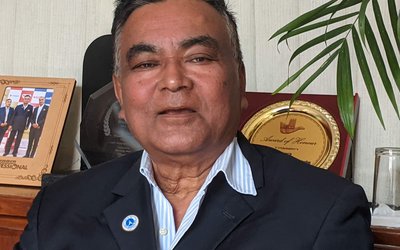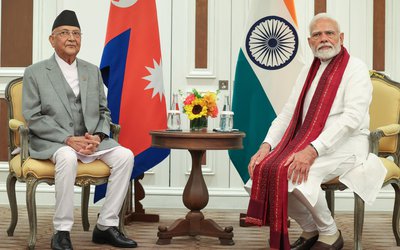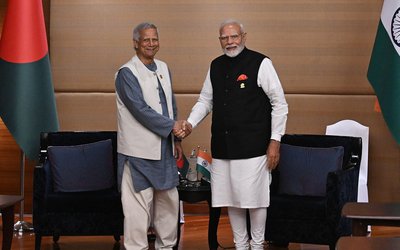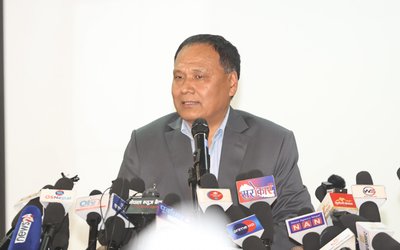
What is the significance for Nepal to celebrate the International Day for Disaster Reduction?
As Nepal is a country prone to natural disasters, it is very significant to celebrate the day and generate awareness and make the government and other stakeholders commit greater engagement with the issue. The slogan 'Step up for Disaster Risk Reduction: Resilience is for life' is very much relevant in Nepal's present context.
Why do you think it so relevant?
Nepal has been annually facing various kinds of disasters and this year's flooding and landslides were one of the worst disasters, with casualties of over 500 deaths and a large number of injuries, along with the huge loss of property. As the recent weather activities have shown that Nepal will have to face more severe disasters in the coming years, the slogan has reminded us about our needs for the coming decades.
As Nepal celebrated the day highlighting the plight of the elderly people, what is the percentage of elderly people who suffered from this year's disaster?
Elderly and children are the most vulnerable to any disaster. As we are in the process of data evaluation, we are yet to know the exact percentage of the casualty of elderly people.
Many countries around the world, including neighboring India, have shown that the early warning system can reduce the number of casualty and loss of property to a certain extent. What about Nepal?
Our experiences have also shown that the Early Warning System is effective to limit the effect and damage of disasters. We have very well placed Early Warning System in the country. In previous years, the system helped a lot to control the damage and save the life of people in mid-western and other parts of the region.
If that is so successful, what went wrong this year?
It is unfortunate that this year's disaster was one of the worst to occur in the last 60 years. As we set up our water gauging system up to 10 meters of water in the river, the water level went over 20 meters in the river. The flood and rainfall were beyond our capability.
Had your Ministry not issued any warning?
In consultation with the metrological forecasting division, we issued warning in Bardiya, Banke and Surkhet districts. However, there was heavy rainfall, which went out of our calculations. Our life saving boats and our system set up to cope with the floods could not match the reality. Despite all these situations, our early warning system still saved life of hundreeds of people and property worth of billions of rupees in Babai and Karnali areas.
It is often said that Nepal's flood management is limited to rescue with the involvement of security personnel in all stages. As Nepal is in the process of drafting the new Disaster Bill, how are you going to accommodate the civilian authority, local bodies and CBOs in the rehabilitation works?
After the recent floods and landslides in Sindhupalchowk, Banke, Bardiya and Surkhet, I have seen the level of awareness and concern on the issue of disasters has gone up tremendously high. We were summoned by almost all Committees of Legislature Parliament. This also helps to make new Disaster relief bill, which is currently with the Ministry, more relevant and accommodative. We learnt a lot during the recent floods. Now we can say what we need in the new act and what role should be given to various stakeholders.
When will you present the bill in the parliament?
The bill is in the final stage and we will table it very soon. As Nepal Army and Nepal Police are always in the forefront of any kind of natural disaster, the bill will give due place to them along with other stakeholders. There is the need to enhance the independent capabilities of the institutions involved in the disasters.
Despite such long experiences, Nepal is yet to reduce the level of casualty and loss of property during disasters. How do you look at this?
Of course, we have made a lot of progress. What we are yet to improve is the level of awareness. We need to increase awareness at the various levels to minimize the level of casualties and loss of life and property. For instance, this year's disaster was much bigger than our capability to cope. Even so, we saved the life of hundreds of people. There is the need of a multiple approach to deal with disasters.
As Nepal is regarded as the third most vulnerable country in the world in terms of disasters, how do you assess the available resources to cope with the situation?
Frankly speaking, there is scarcity of resources. With whatever limited resources are available, we have been doing our best to rescue the people and save their life. We have well established institutional mechanism in the country. As per 2011 United Nations International Strategy for Disaster Reduction, UNISDR , we have already prepared four years of planned program for disaster risk reduction. We also have the National Disaster Risk Reduction Strategy.
- IME GROUP: Expands Into Paper Industry
- Mar 24, 2025
- CPN UML: Instigated By India
- Mar 23, 2025
- ADB’S CHIEF ECONOMIST: Nepal Reduces Poverty
- Mar 11, 2025
- FM DR. DEUBA: A Successful Visit
- Mar 11, 2025
- MD GHISING: Target Of Personal Grudge
- Mar 09, 2025















